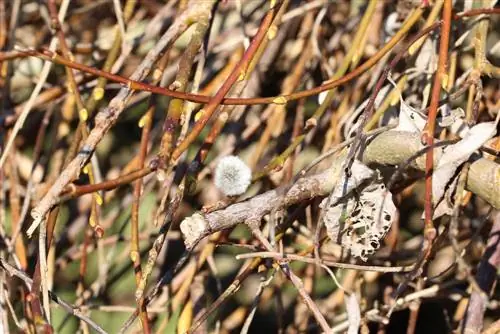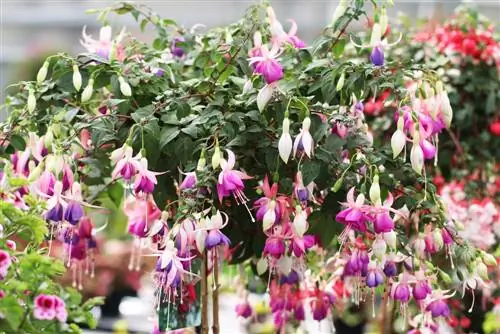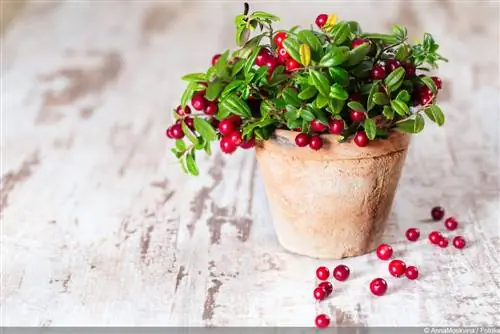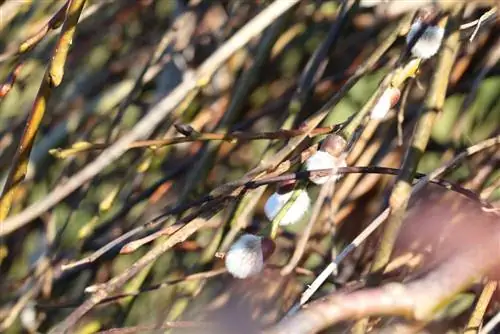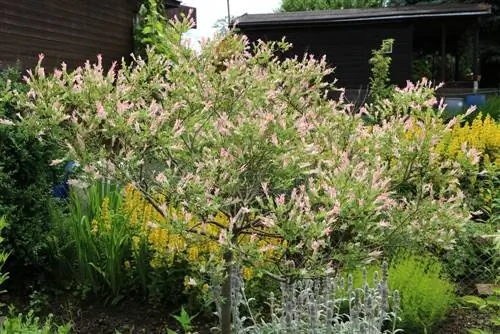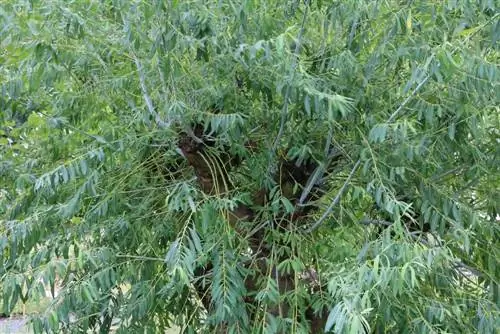- Author admin [email protected].
- Public 2023-12-17 03:39.
- Last modified 2025-06-01 06:48.
The hanging pussy willow (Salix caprea 'Pendula') is a hanging form of the willow (Salix caprea) and an exclusively male willow. It shows its fluffy, delicately scented flowers in March/April. The arched, overhanging shoots of this hanging willow sit on an approximately 80 cm high, medium-thick trunk above the grafting point. Depending on the trunk and grafting height, the plant can reach heights of between 100 and 200cm.
Location requirements
This elegant and very easy-care tree feels equally comfortable in the sun and partial shade, but still prefers locations that are as sunny as possible with at least four hours of sun per day. Specimens in the pot should be placed in a place protected from the wind to prevent them from tipping over in strong winds. As far as the demands on the quality of the soil are concerned, loose and sandy, humus-rich soils offer the best growing conditions.
The hanging willow (Salix caprea 'Pendula') tolerates both alkaline and slightly acidic soils. In general, the soil should be able to store water and nutrients well. For keeping in a pot, you can use commercially available potting soil or high-quality potting or potting soil, which can be enriched with a little sand or perlite.
Planting
In the garden
The decorative hanging willow does not take up much space, which is why it is also very suitable for smaller gardens or front gardens. It can usually be planted from March to October or in spring and autumn, provided the ground is frost-free. The best planting time is between September and November. Then the ground is still warm so that the roots can spread quickly and gain a foothold.
- Water the ball thoroughly before planting
- Dig a planting hole while doing this
- This should be about twice as deep and wide as the bale
- For optimal starting conditions, mix the excavated soil with compost or horn shavings
- If there are several specimens, do not plant them too close together
- Planting too densely hinders the growth of the willows
- Therefore maintain planting distances of 80 - 150 cm
- Now take the willow out of the pot
- Loosen the roots a little with your hands
- Then place in the planting pit
- Plant at the same height as before in the pot
- Insert a support post for better support when planting
- Tie the willow loosely with a coconut rope
- If the willow has grown well, carefully remove the support again
If the plant is in the ground, fill it with excavated soil, press the soil firmly and water the whole thing vigorously. Before watering, it makes sense to create a watering edge around the plant to prevent water from running away. A layer of mulch on the planting area protects the soil from drying out.
Tip:
After insertion, the support should protrude about 10 cm above the crown of the tree. When inserting, particular care must be taken not to damage or injure either the crown or the trunk.
In the bucket

The hanging kitten willow can also set beautiful accents in the pot on the balcony and terrace. When planting in a container, you should first make sure you have a sufficiently large planter. With a capacity of at least 30 - 40 liters, they offer the plant enough space in the first few years. Then add a 5 - 8 cm thick layer of drainage material to the bottom of the bucket, e.g. made of coarse gravel, grit or pottery shards, to ensure good water drainage.
To prevent the substrate and drainage from mixing, cover the gravel with a thin fleece. Then fill up part of the substrate and place the plant in the middle. Then fill the pot with soil up to a few centimeters below the edge, press the soil down and water. It is also advisable to use a support when planting in a container. In the first few weeks after planting, watering should be based on the weather.
Tip:
With the hanging willow (Salix caprea 'Pendula'), the pot should practically grow with the plant. As a result, you should transplant them into a larger container about every 2 - 3 years, otherwise the roots will eventually no longer be adequately supplied with water and nutrients and will wither away.
Care instructions
The hanging pussy willow is usually grafted or grafted onto the trunk of a normal willow. As a result, the trunk grows very slowly, while the shoots with the pretty catkins grow even faster, almost vertically downwards and can eventually hang down to the ground. However, this requires a minimum of care.
Pouring
Basically, the water requirements of a planted pasture are covered by the natural rainfall. Only in summer, when the heat and drought persist, additional watering is necessary to prevent the bale from drying out completely. It is best to water rarely, but thoroughly. This encourages the plants to penetrate into deeper, moist layers of soil in order to better survive longer dry periods. Willows in pots, on the other hand, need to be watered more frequently. Due to the limited volume in the pot, the substrate dries out much more quickly.
Fertilize
This ornamental tree is also relatively undemanding when it comes to nutrient requirements. As a rule, it is sufficient to apply a slow-release fertilizer once in April and again in July. Alternatively, some mature compost can be worked superficially into the soil once a month. If the garden soil is good, you may be able to dispense with additional fertilizer altogether.
Things look a little different with potted plants. Just as the supply of water in planters quickly runs out, the nutrients are also used up much more quickly, meaning that fertilization must be carried out regularly. Therefore, you should supply the plant with a liquid fertilizer once a month from March to August.
Tip:
Intensive fertilizers are generally not suitable for pastures. They would cause the plant to grow too quickly and become bald.
Wintering
Since the hanging willow is a native tree, it copes very well with the local winters. Accordingly, small trees planted in the garden are also hardy, so winter protection is usually unnecessary. Depending on where it is located, you should only protect the trunk from the winter sun.
- Protect the trunk from winter sun with a fleece or similar permeable material
- Protection of the crown is not required
- Plant loses all its leaves in winter
- Specimens in the pot are slightly more sensitive to severe frosts
- To protect the bucket, place it on a wooden pallet or polystyrene plate
- This protects the roots from frost from below
- Wrap the pot additionally with winter protection fleece, bubble wrap or jute
- Choose a sunny spot in the garden for overwintering
Cutting
Salix caprea 'Pendula' is very tolerant of cutting. To ensure that this attractive tree stays in shape, it should be pruned about every two years. The pruning can also be a little more severe. The best time to prune is immediately after flowering. If you cut in early spring, you will have to miss out on the pretty flowers in the same year, so it is better to wait until after they have bloomed.
In order to encourage new growth and to be able to enjoy the elegant catkins again next year, the shoots of the hanging willow are not only shortened, but also cut back to three or four eyes. This cut also ensures that the crown of the tree is not too dense and is always well ventilated.
Old plants should be given a rejuvenation cut to make them more vital again and encourage new, he althy growth. To do this, the main shoots of the crown are cut back to just a few centimeters and all dead parts of the crown are completely removed.
You shouldn't completely forego cutting measures. Otherwise, the proportion of dead shoots inside the crown would increase more and more. These in turn would be overlaid by the new shoots, so that the lowest ones are increasingly shaded and can no longer carry out photosynthesis. If you apply some complete fertilizer after pruning and water the tree thoroughly, the hanging willow should bloom profusely again next year.
Tip:
The resulting clippings can be easily chopped and mixed with the compost or disposed of on the compost heap. Due to the acetylsalicylic acid they contain, also known as aspirin, the chaff is also said to be a very good fertilizer.
Propagate
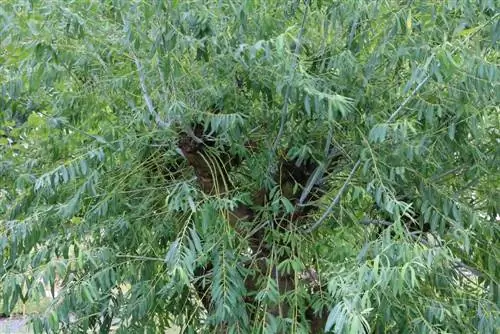
This willow can be propagated both through grafting and cuttings. Refining requires special knowledge, which is why it is better to leave it to the professionals. On the other hand, propagation from cuttings or cuttings is a little less complicated. Cuttings are half-woody and leafy shoot tips, while cuttings are taken from the middle of a shoot, have no leaves and are completely woody. However, rooting does not always occur smoothly; many of them do not root at all. That's why it makes sense to always use several cuttings or cuttings.
- Cuttings and cuttings should be 15 - 20 cm long
- Cut cuttings from annual shoots during the growing season
- Cutting cuttings in autumn or winter
- Remove leaves in the lower part of the cutting
- Then stick both about halfway into loose, lean substrate
- Press the soil well and water it
- Keep the substrate evenly moist until rooting
- Plant rooted cuttings at the end of September or next spring
- Cuttings frost-free, leave to root during the winter
- Plant in the garden in spring
Diseases
Willow Rust is a fungal disease that can occasionally affect the hanging catkins. An infestation manifests itself in the form of yellow and red spots on the leaves, which soon cover the entire leaf. It usually occurs between the end of April and the beginning of May and when there is increased humidity, although the willow can also become infected on other plants. Orange, rust-like spore beds can be seen on the undersides of the leaves.
This fungus can be combated with an appropriate fungicide from specialist retailers. In addition, it is important to completely remove infected leaves from the plant itself, as well as any fallen leaves lying on the ground, and dispose of them with household waste. This is important because this fungus overwinters on the affected leaves and can infect the plant again the next year. In order to generally prevent infestation, the pasture should be trimmed regularly. This prevents the crown from becoming too dense and the leaves from drying out quickly. In addition, you should be careful not to wet the foliage when watering.
Pests
Aphids
Saw willows such as the pussy willow (Salix caprea 'Pendula') are more often attacked by aphids. If you notice an infestation, it can quickly get out of hand. Therefore, combating it should begin as quickly as possible. An immediate measure is to spray with a strong jet of water. This can eliminate a large proportion of these pests.
In addition, infected plants can be sprayed several times with a decoction of nettles or a soft soap solution or treated with commercially available neem products. In addition, the use of beneficial insects such as ladybirds, parasitic wasps, lacewings or earwigs can be helpful. Depending on the species, they are spread either by watering or by attaching or laying out breeding boxes in the immediate vicinity of the source of infestation.
Willow Leaf Beetle
Another pest that can attack this plant is the so-called willow leaf beetle. He can eat the pasture completely bare in a relatively short period of time. As a rule, this beetle does not cause any damage to the tree itself. Control is only possible using a special insecticide. When handling or dosing such agents, you should always adhere to the manufacturer's instructions and administer them accordingly.

